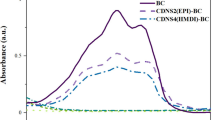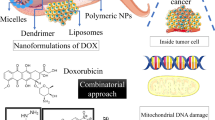Abstract
In recent years, the oral administration of vinorelbine has gradually replaced intravenous administration in the treatment of several types of tumors. Even though the risk of phlebitis is avoided with oral administration, oral vinorelbine is still not a highly patient-compliant route due to the severe gastrointestinal toxicity. Vinorelbine-loaded liposomes with high encapsulation efficiency and suitable particle size were prepared using the ammonium sulfate gradient method. Chitosan-coated liposomes showed the slowest in vitro release compared to uncoated liposomes and vinorelbine solution. No damage was observed in the intestinal epithelial cells of mice orally administered with coated vinorelbine liposomes due to the low presence of the free drug in the gastrointestinal tract and the LD50 was increased from 129.83 to 182.25 mg/kg compared to oral vinorelbine solution. In addition, the positive surface potential of chitosan-coating endowed liposomes with mucosal adhesive function, delaying the time to reach the peak plasma concentration of vinorelbine from 1 to 4 h after administration. And bioavailability was increased to 2.1-fold compared to vinorelbine solution. In short, a new strategy to address the severe gastrointestinal side effects of oral vinorelbine has been developed.









Similar content being viewed by others
References
Bartsch V. Oral vinorelbine: pharmacology and results in the treatment of non-small cell lung cancer and breast cancer. Onkologie. 2006;29:1–28. https://doi.org/10.1159/000091889.
Gebbia V, Puozzo C. Oral versus intravenous vinorelbine: clinical safety profile. Expert Opin Drug Saf. 2005;4(5):915–28. https://doi.org/10.1517/14740338.4.5.915.
Lesueur P, Martel-Laffay I, Escande A, Kissel M, Locher C, Gervais R, et al. Oral vinorelbine-based concomitant chemoradiotherapy in unresectable stage III non-small cell lung cancer: a systematic review. Expert Rev Anticancer Ther. 2018;18(11):1159–65. https://doi.org/10.1080/14737140.2018.1518714.
Urso R, Nencini C, Giorgi G, Fiaschii AI. Chemotherapy-induced myelosuppression by Vinorelbine: a comparison between different dose schedules by simulation. Eur Rev Med Pharmacol Sci. 2007;11(6):413–7.
Yang S-H, Lin C-C, Lin Z-Z, Tseng Y-L, Hong R-L. A phase I and pharmacokinetic study of liposomal vinorelbine in patients with advanced solid tumor. Invest New Drugs. 2012;30(1):282–9. https://doi.org/10.1007/s10637-010-9522-3.
Bonneterre J, Penel N. Vinorelbine in breast cancer. Expert Opin Pharmacother. 2008;9(16):2901–10. https://doi.org/10.1517/14656566.9.16.2901.
Wang T, Shen L, Zhang Z, Li H, Huang R, Zhang Y, et al. A novel core-shell lipid nanoparticle for improving oral administration of water soluble chemotherapeutic agents: inhibited intestinal hydrolysis and enhanced lymphatic absorption. Drug Delivery. 2017;24(1):1565–73. https://doi.org/10.1080/10717544.2017.1386730.
Fricker G, Kromp T, Wendel A, Blume A, Zirkel J, Rebmann H, et al. Phospholipids and lipid-based formulations in oral drug delivery. Pharm Res. 2010;27(8):1469–86. https://doi.org/10.1007/s11095-010-0130-x.
He HS, Lu Y, Qi JP, Zhu QG, Chen ZJ, Wu W. Adapting liposomes for oral drug delivery. Acta Pharmaceutica Sinica B. 2019;9(1):36–48. https://doi.org/10.1016/j.apsb.2018.06.005.
Werle M, Takeuchi H, Bernkop-Schnurch A. Modified chitosans for oral drug delivery. J Pharm Sci. 2009;98(5):1643–56. https://doi.org/10.1002/jps.21550.
Amidi M, Mastrobattista E, Jiskoot W, Hennink WE. Chitosan-based delivery systems for protein therapeutics and antigens. Adv Drug Deliv Rev. 2010;62(1):59–82. https://doi.org/10.1016/j.addr.2009.11.009.
Zhang H, Wang Z-y, Gong W, Li Z-p, Mei X-g, Lv W-l. Development and characteristics of temperature-sensitive liposomes for vinorelbine bitartrate. International Journal of Pharmaceutics. 2011;414(1):56–62. https://doi.org/10.1016/j.ijpharm.2011.05.013.
Nguyen TX, Huang L, Liu L, Abdalla AME, Gauthier M, Yang G. Chitosan-coated nano-liposomes for the oral delivery of berberine hydrochloride. Journal of Materials Chemistry B. 2014;2(41):7149–59. https://doi.org/10.1039/c4tb00876f.
Zhao Y, Ren W, Zhong T, Zhang S, Huang D, Guo Y, et al. Tumor-specific pH-responsive peptide-modified pH-sensitive liposomes containing doxorubicin for enhancing glioma targeting and anti-tumor activity. J Control Release. 2016;222:56–66. https://doi.org/10.1016/j.jconrel.2015.12.006.
Ding N, Wang YX, Wang XL, Chu W, Yin T, Gou JX, et al. Improving plasma stability and antitumor effect of gemcitabine via PEGylated liposome prepared by active drug loading. Journal of Drug Delivery Science and Technology. 2020;57. https://doi.org/10.1016/j.jddst.2020.101538.
Yang WQ, Yang ZM, Fu JR, Guo MR, Sun BJ, Wei W, et al. The influence of trap** agents on the antitumor efficacy of irinotecan liposomes: head-to-head comparison of ammonium sulfate, sulfobutylether–cyclodextrin and sucrose octasulfate. Biomaterials Science. 2019;7(1):419–28. https://doi.org/10.1039/c8bm01175c.
Biruss B, Dietl R, Valenta C. The influence of selected steroid hormones on the physicochemical behaviour of DPPC liposomes. Chem Phys Lipid. 2007;148(2):84–90. https://doi.org/10.1016/j.chemphyslip.2007.04.009.
Soni NK, Sonali LJ, Singh A, Mangla B, Neupane YR, Kohli K. Nanostructured lipid carrier potentiated oral delivery of raloxifene for breast cancer treatment. Nanotechnology. 2020;31(47). https://doi.org/10.1088/1361-6528/abaf81.
Hu S, Niu M, Hu F, Lu Y, Qi J, Yin Z, et al. Integrity and stability of oral liposomes containing bile salts studied in simulated and ex vivo gastrointestinal media. Int J Pharm. 2013;441(1):693–700. https://doi.org/10.1016/j.ijpharm.2012.10.025.
Liu W, Ye A, Liu W, Liu C, Han J, Singh H. Behaviour of liposomes loaded with bovine serum albumin during in vitro digestion. Food Chem. 2015;175:16–24. https://doi.org/10.1016/j.foodchem.2014.11.108.
Kokkona M, Kallinteri P, Fatouros D, Antimisiaris SG. Stability of SUV liposomes in the presence of cholate salts and pancreatic lipases: effect of lipid composition. Eur J Pharm Sci. 2000;9(3):245–52. https://doi.org/10.1016/S0928-0987(99)00064-0.
Yuan H, Chen C-Y, Chai G-h, Du Y-Z, Hu F-Q. Improved transport and absorption through gastrointestinal tract by PEGylated solid lipid nanoparticles. Mol Pharm. 2013;10(5):1865–73. https://doi.org/10.1021/mp300649z.
Meza-Junco J, Sawyer MB. Drug exposure: still an excellent biomarker. Biomark Med. 2009;3(6):723–31. https://doi.org/10.2217/bmm.09.58.
Beckmann G, Fietkau R, Huber RM, Kleine P, Schmidt M, Semrau S, et al. Oral vinorelbine and cisplatin with concomitant radiotherapy in stage III non-small cell lung cancer (NSCLC): A feasibility study. Onkologie. 2006;29(4):137–42. https://doi.org/10.1159/000092062.
Drummond DC, Noble CO, Guo ZX, Hayes ME, Park JW, Ou CJ, et al. Improved pharmacokinetics and efficacy of a highly stable nanoliposomal vinorelbine. J Pharmacol Exp Ther. 2009;328(1):321–30. https://doi.org/10.1124/jpet.108.141200.
Zhou F, Xu T, Zhao Y, Song H, Zhang L, Wu X, et al. Chitosan-coated liposomes as delivery systems for improving the stability and oral bioavailability of acteoside. Food Hydrocolloids. 2018;83:17–24. https://doi.org/10.1016/j.foodhyd.2018.04.040.
Han H-K, Shin H-J, Ha DH. Improved oral bioavailability of alendronate via the mucoadhesive liposomal delivery system. Eur J Pharm Sci. 2012;46(5):500–7. https://doi.org/10.1016/j.ejps.2012.04.002.
Daeihamed M, Dadashzadeh S, Haeri A, Akhlaghi MF. Potential of liposomes for enhancement of oral drug absorption. Curr Drug Deliv. 2017;14(2):289–303. https://doi.org/10.2174/1567201813666160115125756.
Karamanidou T, Bourganis V, Kammona O, Kiparissides C. Lipid-based nanocarriers for the oral administration of biopharmaceutics. Nanomedicine. 2016;11(22):3009–32. https://doi.org/10.2217/nnm-2016-0265.
Pereira de Sousa I, Bernkop-Schnürch A. Pre-systemic metabolism of orally administered drugs and strategies to overcome it. Journal of Controlled Release. 2014;192:301–9. https://doi.org/10.1016/j.jconrel.2014.08.004.
Topletz AR, Dennison JB, Barbuch RJ, Hadden CE, Hall SD, Renbarger JL. The relative contributions of CYP3A4 and CYP3A5 to the metabolism of vinorelbine. Drug Metab Dispos. 2013;41(9):1651–61. https://doi.org/10.1124/dmd.113.051094.
Netsomboon K, Bemkop-Schnurch A. Mucoadhesive vs. mucopenetrating particulate drug delivery. European Journal of Pharmaceutics and Biopharmaceutics. 2016;98:76–89. https://doi.org/10.1016/j.ejpb.2015.11.003.
Prego C, Torres D, Alonso MJ. The potential of chitosan for the oral administration of peptides. Expert Opin Drug Deliv. 2005;2(5):843–54. https://doi.org/10.1517/17425247.2.5.843.
Takeuchi H, Yamamoto H, Niwa T, Hino T, Kawashima Y. Enteral absorption of insulin in rats from mucoadhesive chitosan-coated liposomes. Pharm Res. 1996;13(6):896–901. https://doi.org/10.1023/a:1016009313548.
Liu YH, Yang T, Wei SJ, Zhou CM, Lan Y, Cao AC, et al. Mucus adhesion- and penetration-enhanced liposomes for paclitaxel oral delivery. Int J Pharm. 2018;537(1–2):245–56. https://doi.org/10.1016/j.ijpharm.2017.12.044.
Manconi M, Nácher A, Merino V, Merino-Sanjuan M, Manca ML, Mura C, et al. Improving oral bioavailability and pharmacokinetics of liposomal metformin by glycerolphosphate–chitosan microcomplexation. AAPS PharmSciTech. 2013;14(2):485–96. https://doi.org/10.1208/s12249-013-9926-4.
Schipper NG, Olsson S, Hoogstraate JA, deBoer AG, Varum KM, Artursson P. Chitosans as absorption enhancers for poorly absorbable drugs 2: mechanism of absorption enhancement. Pharm Res. 1997;14(7):923–9. https://doi.org/10.1023/a:1012160102740.
Funding
This work was supported by PhD Research Startup Foundation of Liaoning Province (2020BS-128), National Key R&D Program of China (No. 2020YFE0201700), National Mega-project for Innovative Drugs (No.2019ZX09721001), Liaoning Revitalization Talents Program (XLYC1908031), and National Natural Science Foundation of China (81673378).
Author information
Authors and Affiliations
Contributions
Chen Guo: acquisition, analysis, interpretation, and drafting the work; **chun Zhu: acquisition, analysis, and interpretation; Haoyang Yuan: acquisition, analysis; Haoyu Liu: acquisition, analysis; Tian Yin: analysis, interpretation; Yu Zhang: analysis, interpretation; Haibing He: analysis, interpretation; **gxin Gou: design of the work, analysis, interpretation, and drafting the work. **ng Tang: design of the work, analysis, interpretation, and drafting the work.
Corresponding authors
Ethics declarations
Conflict of Interest
The authors declare no competing interests.
Additional information
Publisher's Note
Springer Nature remains neutral with regard to jurisdictional claims in published maps and institutional affiliations.
Rights and permissions
About this article
Cite this article
Guo, C., Zhu, X., Yuan, H. et al. Chitosan-Coated Liposomes: The Strategy to Reduce Intestinal Toxicity and Improve Bioavailability of Oral Vinorelbine. AAPS PharmSciTech 23, 163 (2022). https://doi.org/10.1208/s12249-022-02308-7
Received:
Accepted:
Published:
DOI: https://doi.org/10.1208/s12249-022-02308-7




